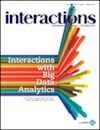Interactions Magazine is (nearly) fully online, archives included

Somehow I hadn’t noticed but Interactions Magazine is now (nearly) fully online.
As far as I could discover (nothing is explained, sic), only some of the current year’s articles are fully available. Yet all the previous issues (up to 15 years ago) are fully available.
The only way to find out what is fully available and what not, is by clicking on an article title (and hoping for the best).
Notwithstanding such a blatant usability error, it is still a major improvement, and this after an unsuccessful battle to achieve this by the likes of Donald Norman, Richard Anderson, Jon Kolko and myself, some years back. The ACM is finally starting to see the light.
Here are the cover and the fully available features stories of the latest issue (May-June 2012)
Interactions with big data analytics (cover story)
Danyel Fisher, Rob Deline, Mary Czerwinski, Steven Drucker
We report on the state of the practice of big data analytics, based on a series of interviews we conducted with 16 analysts. While the problems uncovered are pain points for big data analysts (including HCI practitioners), the opportunity for better user experience around each of these areas is vast. It is our hope that HCI researchers will not only turn their attention toward designs that improve the big data research experience, but that they will also cautiously embrace the big data available to them as a converging line of evidence in their iterative design work.
Technologies for aging gracefully
Ronald Baecker, Karyn Moffatt, Michael Massimi
Technology by itself cannot solve these [aging] problems. Yet technology designed to empower older adults and to make them more capable, resourceful, and independent can help.
Interaction as performance
Steve Benford, Gabriella Giannachi
Our overall goal is to lay the foundations for a “dramaturgy of performance†by establishing a framework of concepts — a language, if you like — to help express the different ways in which computers can be embedded into performative experiences. We intend this framework to guide practitioners and researchers who are entering the field of artistic, performance, and cultural applications of computing. However, we also aim to stimulate wider thinking in HCI in general around the changing nature of the extended user experience and the new challenges this raises.



